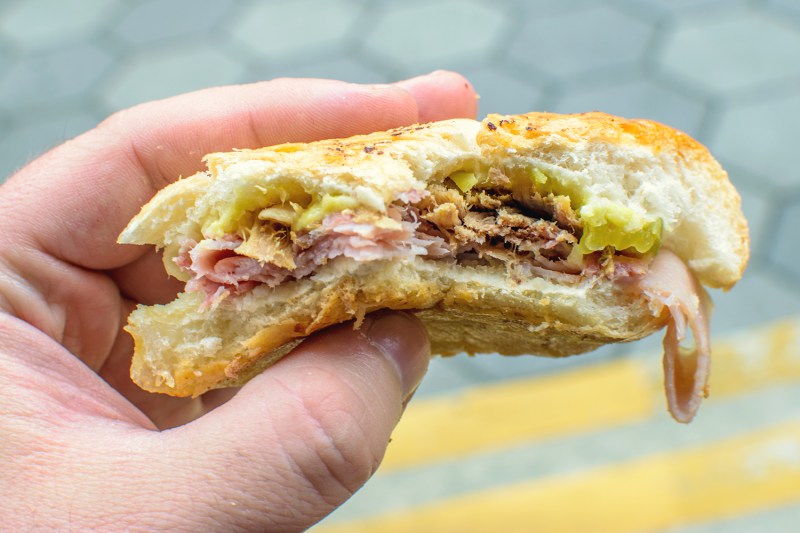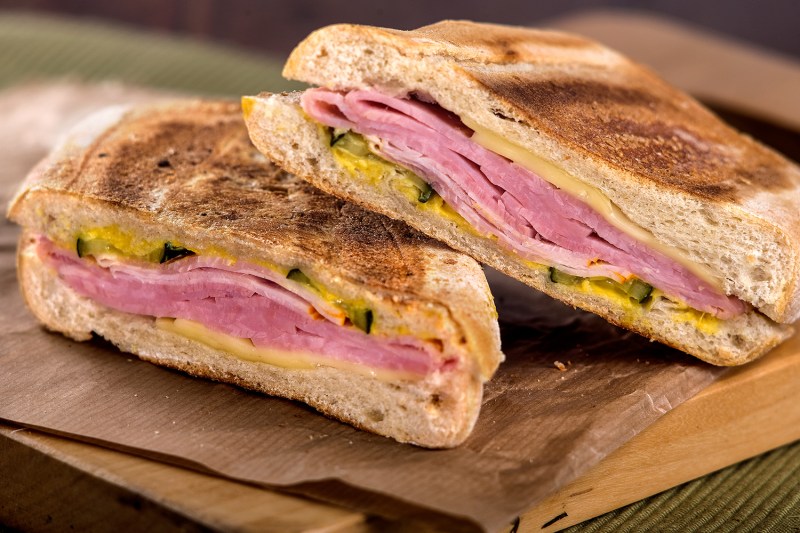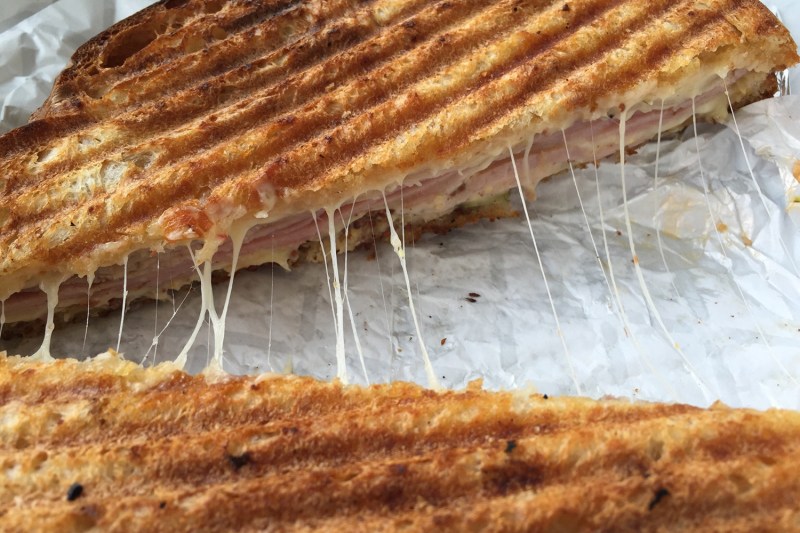
A South Florida creation dating back to the turn of the century, the Cuban sandwich (also known as the Cubano) is a flavorful spin on the classic ham and cheese. The Cubano often includes creative additions and ingredient swaps, but at its essence, this grilled sandwich involves Cuban bread, thin-sliced ham, roasted pork, deli pickles, and a hearty swipe of mustard. It’s a handheld masterpiece that appeals to all flavor centers … and if you’re armed with the following seven useful tips from pro chefs, the Cuban sandwich can be easily re-created in the comfort of your own kitchen.
Pay attention to the marinades used for your pork and pickles.
The rich umami of roasted pork and the bright tang of pickled cucumbers are crucial to the Cuban sandwich’s appeal, so it’s important to get your brines, marinades, and cooking times right. Chef Lisa Toro of The Liquor Store in Memphis, Tennessee uses a “12- to 16-hour seasoned and roasted pork shoulder” for her Cuban sandwiches, allowing the slow marination process and gentle roasting to infuse the pork with as much flavor as possible.
Chef Julian Medina of Latineria in New York City tells us that “the key ingredients to an amazing Cuban sandwich are the pork and the pickles. Marinate the pork shoulder for two days in a mix of garlic, fresh herbs and olive oil, then slow-roast it so the meat gets a nice sear all around it. For the pickles, make [a brine] with rice vinegar, dill, and chiles de Arbol for a tart and spicy aspect.”
Don’t skimp on the quality of cheese.
Look, we get it. The cheese counter is a notorious money vortex, and it can feel a bit silly to drop big bucks on a block of dairy that’s intended for a sandwich rather than a cheese board. But when it comes to a well-executed Cubano, quality cheese is a must-have. And according to culinary director Tom Berry of the soon-to-open Mariel in Boston, MA only one type of cheese will do: “Cave-aged Gruyere maketh a Cubano.”

Feel free to play around with the mustard.
A traditional Cubano includes yellow mustard, but depending on your flavor preferences, blending different mustard styles can result in a tastier sandwich. “Mix together two parts classic yellow mustard with one part Dijon and one part whole-grain mustard for a slightly more complex mustard flavor without straying away from what makes this a Cubano,” recommends Chef Dillon Misonznick of Spicy Boys in Austin, Texas.
If you can’t find proper “Cuban bread,” look for bread with high egg content like a brioche
In an ideal world, a Cuban sandwich would always be built on Cuban bread, a version of white bread considered a regional specialty of South Florida. ““You must use real Cuban bread, or it’s not a Cubano! What makes Cuban bread unique is the use of all white flour and lard,” insists restauranteur Joe Santos of Havana 1920 in San Diego.
But if you’re unable to find Cuban bread at your local grocery store or bakery, Chef Alfredo Noguiera of Cane & Table and Cure in New Orleans offers a solid alternative: an egg-based bread with a lightweight texture. “Go for a bread that is more of brioche, which is typical for a style [of the Cuban sandwich] called ‘medianoche’,” Noguiera tells The Manual.
Thoroughly “lubricate” the bread before pressing.
The Cuban sandwich gets its crispy crust and rich melted cheese from a pressing process somewhat akin to the one used for paninis. As with any other grilled sandwich, the bread used for a Cubano must be prepped prior to its placement on the press, an endeavor requiring a fat-based “lubricant.” “Traditionally, margarine is used to toast the bread,” explains Misonznick, “but you can kick it up a notch by mixing some fresh pork lard with the margarine.”
Press each slice of bread individually before assembling and pressing the sandwich.
The textural contrast of crunchy bread and soft fillings proves a major selling point of the Cubano. In the interest of emphasizing that aspect of the sandwich, Chef Michael C. Brown of Barrel Republic in San Diego puts in some extra time at the press: “I like to press each side of the bread individually, then add the additional ingredients, then press again to get a nicely compressed sandwich.”

Let the sandwich press “do its thing.”
Don’t have a sandwich press at home? Luckily, there’s an easy shortcut to getting your Cubano perfectly griddled: “If you don’t have a sandwich press, you can press the sandwiches between two hot cast iron skillets,” suggests chef and butcher Rusty Bowers of Pine Street Market in Atlanta, Georgia.
Whether you’re using a traditional press or a MacGyver-ed version, resist the urge to interfere with the process. “Once you have all the good quality ingredients down, it’s all about the press. You want to lightly press the sandwich instead of forcing the press. Place [the Cubano] on the sandwich press and let it do its thing. You don’t need to force it shut; the press will happen naturally,” states Chef Michael Beltran of Chug’s in Miami.
If you want to try making a Cubano at home, this recipe provides a clear road map to a traditional and satisfying Cuban sandwich:
The Butcher’s Cuban Sandwich Recipe
(Created by Rusty Bowers, Pine Street Market, Atlanta, Georgia)
Ingredients:
- 2 7-inch bread loaves (Bowers prefers ciabatta)
- 4 slices of mild sharp Cheddar or Swiss cheese
- 6 oz shredded pork
- 6 slices of ham
- 2 oz butter, at room temperature
- Cucumber pickles, to taste
- Mustard, to taste (Bowers prefers hot honey mustard)
Method:
- Preheat the sandwich press to medium.
- Slice the bread lengthwise and spread mustard on the open-cut sides.
- Place two slices of cheese on each bottom slice of bread. Top with an even layer of pork and ham. Top the meat with pickles and the top half of the bread.
- Brush each side of the bread with butter. Place the sandwiches in the press and grill until the cheese is melted and the bread browns, approximately 8-10 minutes.
- Let the sandwiches rest for 2 minutes before serving.



